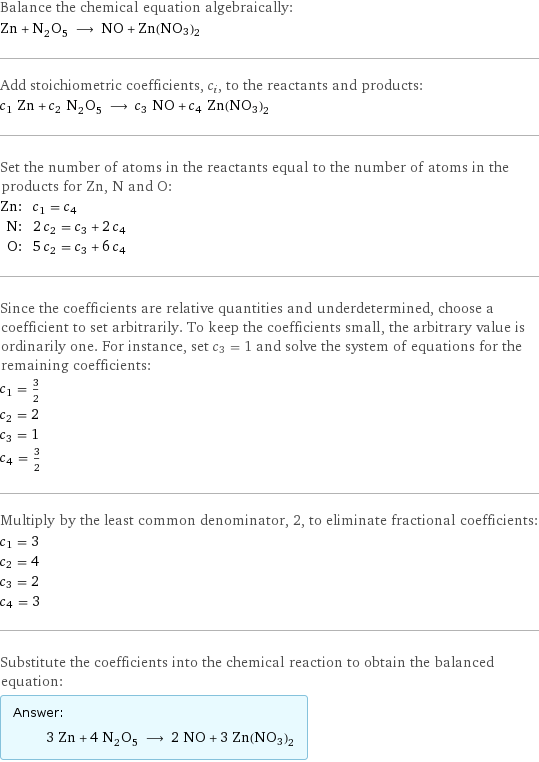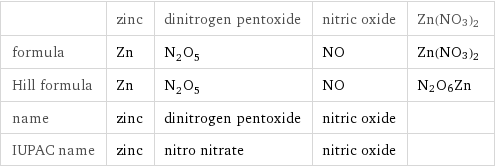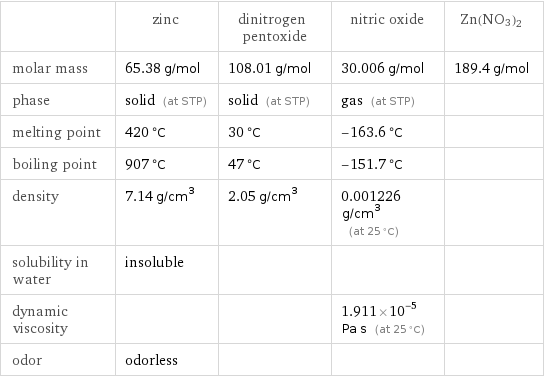Input interpretation

Zn zinc + N_2O_5 dinitrogen pentoxide ⟶ NO nitric oxide + Zn(NO3)2
Balanced equation

Balance the chemical equation algebraically: Zn + N_2O_5 ⟶ NO + Zn(NO3)2 Add stoichiometric coefficients, c_i, to the reactants and products: c_1 Zn + c_2 N_2O_5 ⟶ c_3 NO + c_4 Zn(NO3)2 Set the number of atoms in the reactants equal to the number of atoms in the products for Zn, N and O: Zn: | c_1 = c_4 N: | 2 c_2 = c_3 + 2 c_4 O: | 5 c_2 = c_3 + 6 c_4 Since the coefficients are relative quantities and underdetermined, choose a coefficient to set arbitrarily. To keep the coefficients small, the arbitrary value is ordinarily one. For instance, set c_3 = 1 and solve the system of equations for the remaining coefficients: c_1 = 3/2 c_2 = 2 c_3 = 1 c_4 = 3/2 Multiply by the least common denominator, 2, to eliminate fractional coefficients: c_1 = 3 c_2 = 4 c_3 = 2 c_4 = 3 Substitute the coefficients into the chemical reaction to obtain the balanced equation: Answer: | | 3 Zn + 4 N_2O_5 ⟶ 2 NO + 3 Zn(NO3)2
Structures

+ ⟶ + Zn(NO3)2
Names

zinc + dinitrogen pentoxide ⟶ nitric oxide + Zn(NO3)2
Equilibrium constant
![Construct the equilibrium constant, K, expression for: Zn + N_2O_5 ⟶ NO + Zn(NO3)2 Plan: • Balance the chemical equation. • Determine the stoichiometric numbers. • Assemble the activity expression for each chemical species. • Use the activity expressions to build the equilibrium constant expression. Write the balanced chemical equation: 3 Zn + 4 N_2O_5 ⟶ 2 NO + 3 Zn(NO3)2 Assign stoichiometric numbers, ν_i, using the stoichiometric coefficients, c_i, from the balanced chemical equation in the following manner: ν_i = -c_i for reactants and ν_i = c_i for products: chemical species | c_i | ν_i Zn | 3 | -3 N_2O_5 | 4 | -4 NO | 2 | 2 Zn(NO3)2 | 3 | 3 Assemble the activity expressions accounting for the state of matter and ν_i: chemical species | c_i | ν_i | activity expression Zn | 3 | -3 | ([Zn])^(-3) N_2O_5 | 4 | -4 | ([N2O5])^(-4) NO | 2 | 2 | ([NO])^2 Zn(NO3)2 | 3 | 3 | ([Zn(NO3)2])^3 The equilibrium constant symbol in the concentration basis is: K_c Mulitply the activity expressions to arrive at the K_c expression: Answer: | | K_c = ([Zn])^(-3) ([N2O5])^(-4) ([NO])^2 ([Zn(NO3)2])^3 = (([NO])^2 ([Zn(NO3)2])^3)/(([Zn])^3 ([N2O5])^4)](../image_source/156d1a931e1b8b7dfb73885d376a03f7.png)
Construct the equilibrium constant, K, expression for: Zn + N_2O_5 ⟶ NO + Zn(NO3)2 Plan: • Balance the chemical equation. • Determine the stoichiometric numbers. • Assemble the activity expression for each chemical species. • Use the activity expressions to build the equilibrium constant expression. Write the balanced chemical equation: 3 Zn + 4 N_2O_5 ⟶ 2 NO + 3 Zn(NO3)2 Assign stoichiometric numbers, ν_i, using the stoichiometric coefficients, c_i, from the balanced chemical equation in the following manner: ν_i = -c_i for reactants and ν_i = c_i for products: chemical species | c_i | ν_i Zn | 3 | -3 N_2O_5 | 4 | -4 NO | 2 | 2 Zn(NO3)2 | 3 | 3 Assemble the activity expressions accounting for the state of matter and ν_i: chemical species | c_i | ν_i | activity expression Zn | 3 | -3 | ([Zn])^(-3) N_2O_5 | 4 | -4 | ([N2O5])^(-4) NO | 2 | 2 | ([NO])^2 Zn(NO3)2 | 3 | 3 | ([Zn(NO3)2])^3 The equilibrium constant symbol in the concentration basis is: K_c Mulitply the activity expressions to arrive at the K_c expression: Answer: | | K_c = ([Zn])^(-3) ([N2O5])^(-4) ([NO])^2 ([Zn(NO3)2])^3 = (([NO])^2 ([Zn(NO3)2])^3)/(([Zn])^3 ([N2O5])^4)
Rate of reaction
![Construct the rate of reaction expression for: Zn + N_2O_5 ⟶ NO + Zn(NO3)2 Plan: • Balance the chemical equation. • Determine the stoichiometric numbers. • Assemble the rate term for each chemical species. • Write the rate of reaction expression. Write the balanced chemical equation: 3 Zn + 4 N_2O_5 ⟶ 2 NO + 3 Zn(NO3)2 Assign stoichiometric numbers, ν_i, using the stoichiometric coefficients, c_i, from the balanced chemical equation in the following manner: ν_i = -c_i for reactants and ν_i = c_i for products: chemical species | c_i | ν_i Zn | 3 | -3 N_2O_5 | 4 | -4 NO | 2 | 2 Zn(NO3)2 | 3 | 3 The rate term for each chemical species, B_i, is 1/ν_i(Δ[B_i])/(Δt) where [B_i] is the amount concentration and t is time: chemical species | c_i | ν_i | rate term Zn | 3 | -3 | -1/3 (Δ[Zn])/(Δt) N_2O_5 | 4 | -4 | -1/4 (Δ[N2O5])/(Δt) NO | 2 | 2 | 1/2 (Δ[NO])/(Δt) Zn(NO3)2 | 3 | 3 | 1/3 (Δ[Zn(NO3)2])/(Δt) (for infinitesimal rate of change, replace Δ with d) Set the rate terms equal to each other to arrive at the rate expression: Answer: | | rate = -1/3 (Δ[Zn])/(Δt) = -1/4 (Δ[N2O5])/(Δt) = 1/2 (Δ[NO])/(Δt) = 1/3 (Δ[Zn(NO3)2])/(Δt) (assuming constant volume and no accumulation of intermediates or side products)](../image_source/71c8c10404b4d1b13f9c530361271056.png)
Construct the rate of reaction expression for: Zn + N_2O_5 ⟶ NO + Zn(NO3)2 Plan: • Balance the chemical equation. • Determine the stoichiometric numbers. • Assemble the rate term for each chemical species. • Write the rate of reaction expression. Write the balanced chemical equation: 3 Zn + 4 N_2O_5 ⟶ 2 NO + 3 Zn(NO3)2 Assign stoichiometric numbers, ν_i, using the stoichiometric coefficients, c_i, from the balanced chemical equation in the following manner: ν_i = -c_i for reactants and ν_i = c_i for products: chemical species | c_i | ν_i Zn | 3 | -3 N_2O_5 | 4 | -4 NO | 2 | 2 Zn(NO3)2 | 3 | 3 The rate term for each chemical species, B_i, is 1/ν_i(Δ[B_i])/(Δt) where [B_i] is the amount concentration and t is time: chemical species | c_i | ν_i | rate term Zn | 3 | -3 | -1/3 (Δ[Zn])/(Δt) N_2O_5 | 4 | -4 | -1/4 (Δ[N2O5])/(Δt) NO | 2 | 2 | 1/2 (Δ[NO])/(Δt) Zn(NO3)2 | 3 | 3 | 1/3 (Δ[Zn(NO3)2])/(Δt) (for infinitesimal rate of change, replace Δ with d) Set the rate terms equal to each other to arrive at the rate expression: Answer: | | rate = -1/3 (Δ[Zn])/(Δt) = -1/4 (Δ[N2O5])/(Δt) = 1/2 (Δ[NO])/(Δt) = 1/3 (Δ[Zn(NO3)2])/(Δt) (assuming constant volume and no accumulation of intermediates or side products)
Chemical names and formulas

| zinc | dinitrogen pentoxide | nitric oxide | Zn(NO3)2 formula | Zn | N_2O_5 | NO | Zn(NO3)2 Hill formula | Zn | N_2O_5 | NO | N2O6Zn name | zinc | dinitrogen pentoxide | nitric oxide | IUPAC name | zinc | nitro nitrate | nitric oxide |
Substance properties

| zinc | dinitrogen pentoxide | nitric oxide | Zn(NO3)2 molar mass | 65.38 g/mol | 108.01 g/mol | 30.006 g/mol | 189.4 g/mol phase | solid (at STP) | solid (at STP) | gas (at STP) | melting point | 420 °C | 30 °C | -163.6 °C | boiling point | 907 °C | 47 °C | -151.7 °C | density | 7.14 g/cm^3 | 2.05 g/cm^3 | 0.001226 g/cm^3 (at 25 °C) | solubility in water | insoluble | | | dynamic viscosity | | | 1.911×10^-5 Pa s (at 25 °C) | odor | odorless | | |
Units
